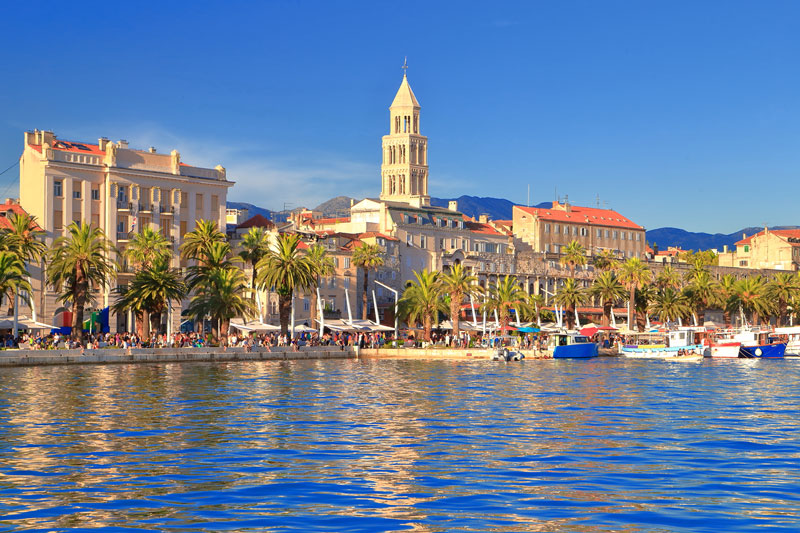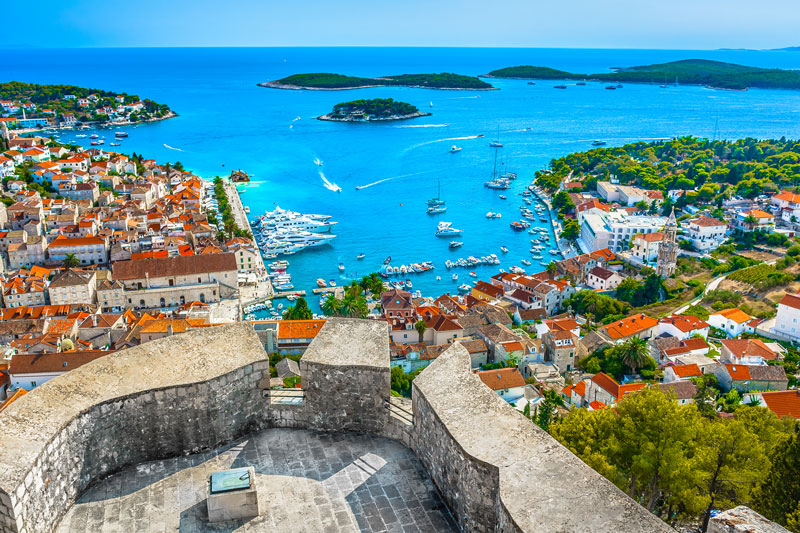Croatia’s second city of Split is the source of much regional pride, enjoying a fierce rivalry with Zagreb in everything from fashion to football.
This is a modern, bustling port city with street life centred on the waterfront Riva, crowded with open-air cafes. The main sights are situated around Diocletian’s Palace and on the Marjan Peninsula to the west. The best-known attraction on Brac may be the beach at Zlatni Rat, but there is more to the island than that. This is the largest island off the Dalmatian coast and famous for its white marble stone, quarried here since Roman times and used in buildings ranging from the Diocletian’s Palace in Split to Liverpool Cathedral and the White House in Washington.
The sunniest island in the Adriatic, Hvar is an idyllic place of lavender fields and vineyards, whose capital is fast becoming Croatia’s glitziest resort. The scent of sage and rosemary hangs in the air, and during the lavender harvest in early summer the countryside is a riot of purple colour.
Itinerary – Split, Brac & Hvar

Day 1 – Split
Split, Croatia's second-largest city, has some first-class charms and is located on the glittering Adriatic Sea in central Dalmatia. Its rolling terrain slopes down to pebbly beaches and turquoise waters, which look out onto neighboring islands like trendy Hvar. It has played host to an incredible amount of history: think Roman emperor Diocletian, who started building his palace in A.D. 295. But despite its historical cachet, Split isn't stuck in the past - these days its labyrinthine medieval palace contains buzzy bars, happening restaurants and fashionable shops and the sun nearly always shines.
Day 2 – Komiza
With a picturesque setting on a bay at the foot of Hum Mountain, this small town has diehard fans among Croats, who swear by its somewhat-bohemian, rough-around-the-edges ambience. Narrow backstreets lined with 17th & 18th century stone town houses twist uphill from the port, which has been used by fisherfolk since at least the 12th century. A friendly rivalry exists between Komiza and Vis Town. The latter was historically associated with the nobility, while Komiza is proud of its working-class fishing heritage and pirate tales. Komiza has its own little sand and pebble beaches, with the opportunity to visit the Blue Cave on the nearby island of Bisevo.


Day 3 – Vis
Of all the inhabited Croatian islands, Vis is the furthest from the coast and the most enigmatic. It spent much of its recent history serving as a Yugoslav military base, cut off from foreign visitors from the 1950s right up until 1989. This isolation preserved the island from development and drove much of the population to move elsewhere in search of work, leaving it underpopulated for many years. As has happened with impoverished islands across the Mediterranean, Vis’ lack of development has become its drawcard as a tourist destination. International and local travellers alike now flock to Vis, seeking authenticity, nature, gourmet delights and peace and quiet. That only increased following the 2018 release of the movie Mamma Mia! Here We Go Again, filmed on the island. Vis has its own distinct grape, vugava, a white varietal that's been cultivated here since ancient times.
Day 4 – Hvar
Long, lean Hvar is vaguely shaped like the profile of a holidaymaker reclining on a sun lounger which is altogether appropriate for the sunniest spot in the country and its most luxurious beach destination. Hvar Town offers swanky hotels, elegant restaurants, and a general sense that, if you care about seeing and being seen, this is the place to be. Rubbing shoulders with the posh yachties are hundreds of young partygoers, dancing on tables at the town's legendary beach bars. Hvar's interior hides abandoned ancient hamlets, craggy peaks, vineyards, and the lavender fields that the island is famous for.


Day 5 – Stari Grad
Stari Grad, on Hvar’s north coast, is a quieter, more cultured and altogether more sober affair than Hvar Town, its stylish and sybaritic sister. The name Stari Grad means 'Old Town', a reference to the fact that it was founded in 384 BC by the ancient Greeks, who called it Pharos. The surrounding fields are still divided into parcels of land demarcated in antiquity. The town sits at the end of a deep inlet, with the narrow lanes of the old quarter spreading out on its southern side. The waterfront promenade continues along the northern bank to a small beach.
Day 6 – Milna
Milna is a picture-perfect Dalmatian village, located on the north side on the island of Brač which features idyllic evening sunsets. This quaint island village is a welcome reprieve from the hustle and bustle of neighbouring islands, brimming with authentic Croatian experiences and friendly locals that take the Pomalo (slowly) way of life seriously. The island of Brač offers a plethora of activities and experiences for every traveler. Whether you’re looking to visit one of the most beautiful beaches in Europe, learn from the best at the only stonemasonry school in Croatia or sample locally produced wine and olives, Milna is the perfect base from which to explore all the island has to offer.

